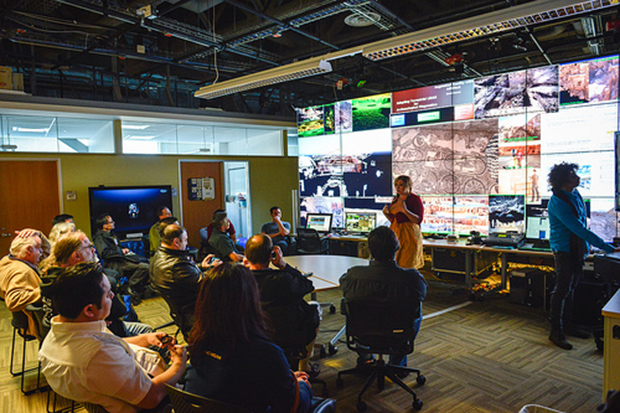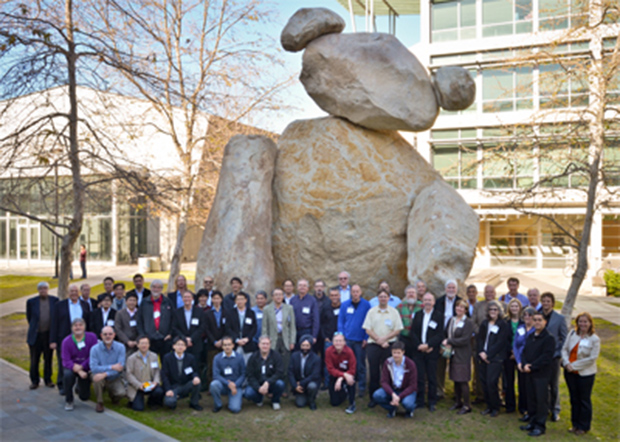California Research and Education Network Traffic Doubles
One of the World’s Most Advanced Networks Moves 18 Petabytes in February 2013
By:
- Doug Ramsey
Published Date
By:
- Doug Ramsey
Share This:
Article Content
Soon after the conclusion of its conference on the University of California, San Diego campus about the future of research networks in California, the Corporation for Education Network Initiatives in California (CENIC) announced a record-breaking year for the network that provides high-performance connectivity to over 10 million Californians every day.

NSF-funded graduate students at Calit2 demonstrate their research results for visitors attending the "100G and Beyond" workshop organized by CENIC and ESnet, and hosted by Calit2 UC San Diego
CENIC’s California Research and Education Network (CalREN) is the advanced network that serves California’s K-20 research and education communities. Traffic flowing through CalREN to external networks topped out at 18 petabytes in February 2013, with a 99 percent growth rate over February 2012. (One petabyte equals one million gigabytes, or 10 to the power of 15 bytes.) The growth rate from January 2012 to January 2013 was similarly impressive at 93 percent.
CalREN consists of nearly 3,000 miles of fiber-optic cable running throughout California to which institutions in all 58 of the state’s counties connect via leased lines or dark fiber. It links nearly 10,000 California K-12 sites, the 112 campuses of California’s Community Colleges, all 23 campuses of the California State University, UC San Diego and the other nine campuses of the University of California, private universities including Caltech, Stanford University, and the University of Southern California, along with numerous off-campus sites and other institutions. As well as connecting the vast majority of California’s K-20 research and education communities with one another, CalREN also links them with colleagues globally at extremely high speeds through its connections with other similar networks throughout the world.
“These impressive trends in traffic growth are only the beginning of a new era for CalREN and the CENIC communities,” said CENIC President and CEO Louis Fox. “In the months to come, CENIC will begin implementing 100G connectivity to CalREN for certain institutions in California. Of course, the West Coast backbone for the Pacific Wave international peering exchange by which CalREN connects to similar networks in the Pacific Rim is also operating at 100G, so we look forward to accelerating this growth in network traffic even more in the future.”

Attendees at the "100G and Beyond" workshop at UC San Diego
Pacific Wave is an international peering exchange operated by CENIC together with the Pacific Northwest Gigapop and is operated in collaboration with the University of Southern California and the University of Washington. Over 40 countries’ advanced networks peer with one another at any of five locations in three cities along the US West Coast, all connected by a 100G backbone.
“100G networking is transformational,” said Greg Bell, Director of the Energy Sciences Network (ESnet). “Faster data means faster discovery in fields as diverse as genomics, particle physics, climate, and materials sciences. This exciting year of record growth for CENIC is very likely just the tip of the iceberg.”
Last month, CENIC also previewed ultra-high-speed, network-enabled research at an invited workshop co-sponsored with the California Institute for Telecommunications and Information Technology (Calit2) and the US Department of Energy’s Energy Sciences Network (ESnet), and held at Calit2’s Atkinson Hall on the campus of UC San Diego.
Speakers and attendees at “100G and Beyond: Ultra High Performance Networking in California” examined the ways in which 100G networking will revolutionize scientific, medical, media arts, smart manufacturing, scientific workflows, and network research itself as well as examining the campus cyberinfrastructure necessary to enable campuses to take full advantage of the coming bandwidth.
“CENIC’s leadership in rapidly upgrading to 100G is critical to maintaining the competitiveness of California’s research institutions,” said Larry Smarr, founding director of Calit2. “The National Science Foundation just awarded UCSD a grant to build 10-80Gbps dedicated optical fibers across the campus connecting our data-intensive researchers. Obviously, UCSD will require a 100G connection to CENIC, and through it to the national and international research networks, to make effective use of UCSD’s new Big Data Freeway system.”
Share This:
You May Also Like
Stay in the Know
Keep up with all the latest from UC San Diego. Subscribe to the newsletter today.



